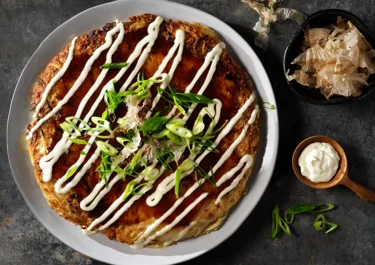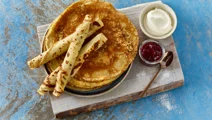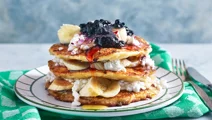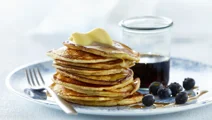
Okonomiyaki pancake with cabbage

Instructions
Okonomiyaki sauce
Pancake
Recommended information
Serving suggestion
Thoroughly mix the batter before adding cabbage
To achieve the perfect okonomiyaki, start by thoroughly mixing your batter until it’s smooth. This essential step prevents lumps and ensures an even distribution of flour, which is fundamental for a well-textured pancake. However, once you incorporate the cabbage and other ingredients, minimise your mixing. Over-stirring at this stage can break down the cabbage, releasing excess water into the batter and resulting in a consistency that is too runny, potentially compromising the texture of your okonomiyaki.
Master the sauce
The sauce greatly improves the taste of this traditional Japanese dish, offering a rich, umami flavour that complements this cabbage pancake. Start by carefully balancing soy sauce, Worcestershire for a balanced, sweet-savoury base. For added depth, try adding a small amount of oyster sauce or a dash of mirin for a hint of sweetness. Stir the cornstarch into cold water to prevent clumps before adding to the sauce as a thickener; this will give it a smooth, glossy finish. Cook over low heat, stirring constantly, until it thickens to a rich, velvety texture. Taste as you go and adjust with extra soy sauce for saltiness or a squeeze of lemon for a subtle tang. Let the sauce cool to slightly thicken before drizzling it over your okonomiyaki.
Substitutes for traditional cabbage pancake toppings
If you need substitutes for traditional Japanese toppings like nori sheets, dried seaweed or bonito flakes, there are plenty of options to try. Instead of bonito flakes, which add a smoky umami flavour, you can sprinkle crispy fried onions or sesame seeds for added crunch. Swap out nori seaweed with finely chopped fresh herbs like chives or green onions to bring a fresh, mild flavour. These substitutions keep the essence of okonomiyaki while adding a personal twist to the toppings, even when traditional ingredients are unavailable.
Questions about okonomiyaki
Okonomiyaki, also known as Japan's savoury cabbage pancake, offers a delightful mix of flavours and textures. Below, we answer some common questions about this versatile dish, covering everything from its essential ingredients to how to perfect its preparation. Whether you're an experienced chef or just starting out, these insights will help you master this recipe.
Nutritional values
Nutritional value, per
1855 Kcal
| Fibre | 20.6 gram fibers |
| Protein | 49.3 |
| Carbohydrates | 210.7 |
| Fat | 90.3 gram |
Ingredients
Okonomiyaki sauce
Japanese soya sauce | 50 ml |
|---|---|
Worcestershire sauce | 50 ml |
Water | 50 ml |
Powdered sugar | 2 tbsp |
White wine vinegar | 2 tbsp |
Finely grated fresh ginger | 2 tsp |
Corn starch | 1 tsp |
Pancake
Eggs | 4 |
|---|---|
Flour | 210 g |
Water | 250 ml |
Salt | 1 tsp |
Bacon | 140 g |
Cabbages | 500 g |
Spring onions | 3 |
Pickled ginger | 2 tbsp |
Butter | 2 tbsp |
To serve
Sour cream | 100 ml |
|---|---|
Nori seaweed sheets, dried seaweed or bonito flakes |
Level up your okonomiyaki with skyr
Skyr – a thick, creamy Icelandic yoghurt – pairs exceptionally well with this recipe. Its subtle tang and velvety texture perfectly complement the savoury, crispy cabbage pancake, balancing the richness of the traditional toppings like okonomiyaki sauce and mayonnaise. You can mix skyr with a bit of lemon juice or herbs for a fresh twist, or simply serve it on the side for dipping. This addition not only adds a unique flavour but also makes each bite extra satisfying, bringing a new, modern touch to this classic Japanese dish.
Can I use a different sauce?
Absolutely! While the traditional okonomiyaki sauce is a tangy, slightly sweet condiment, you could try teriyaki sauce for a richer, sweeter flavour, or even a mix of soy sauce and a touch of honey for a simpler alternative. For a spicy kick, drizzle sriracha or a spicy mayo on top. Hoisin sauce mixed with a bit of vinegar can also mimic the thick, savoury-sweet profile of okonomiyaki sauce. These variations allow you to experiment and find the perfect sauce to suit your taste!
If you’re in the mood for something sweeter, give our Japanese pancakes a try. These fluffy, souffle-style pancakes are irresistibly light and airy, topped with rich maple syrup butter that melts into every bite, creating the perfect balance of sweetness and indulgence.
What are the key ingredients for an authentic flavour?
To achieve an authentic flavour, a few key ingredients make all the difference. First, fresh cabbage is essential for texture, adding a satisfying crunch to each bite. Traditional toppings like okonomiyaki sauce and Japanese mayonnaise add the signature sweet, tangy, and creamy notes, while nori seaweed and bonito flakes bring a salty, smoky depth and an extra layer of authenticity. Together, these ingredients create the classic, well-balanced flavour that makes okonomiyaki so beloved.
Use a lid for even cooking
Using a lid while cooking your cabbage pancakes is a great way to ensure even cooking. Covering the pan traps heat and steam, allowing the inside of the pancake to cook through while the outside becomes golden and slightly crispy. This method also helps the cabbage soften, making the pancake tender and flavourful. Just place a lid over the pan after pouring in the batter, and cook on medium heat until the top sets, then flip and finish cooking the other side. This simple step will give you a perfectly cooked okonomiyaki with a soft centre and crisp edges.
Adjust the thickness of your okonomiyaki
For a thicker, fluffier cabbage pancake, add extra batter and cook on a lower heat for a longer time to ensure it cooks through without burning. If you prefer a thinner, crispier okonomiyaki, spread the batter more thinly in the pan and cook over medium-high heat, which will give it a delightful crunch. Keep in mind that a thicker pancake may need to be covered with a lid to cook evenly, while a thinner version usually cooks faster without a lid. Adjusting the thickness is a simple way to make your okonomiyaki just the way you like it.
Adapting the recipe for different sizes
Okonomiyaki is remarkably versatile, not only in ingredients but also in size, letting you enjoy and serve the dish in various ways. For individual servings or appetisers, simply reduce the batter to create smaller, snack-sized pancakes that cook quickly and are perfect for sharing.
For a larger, family-style okonomiyaki, pour all the batter into a larger pan, and cook over a lower heat to ensure even cooking throughout; you may need to finish it in the oven to cook the centre thoroughly. Adjusting the size is also handy for customising servings for different occasions – small pancakes for parties, or a large one to serve as a main course.











